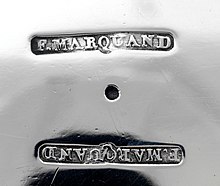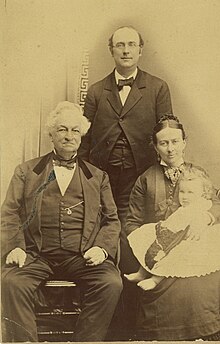 | |
| Founded | 1804, New York City & Savannah, Georgia |
|---|---|
| Founder | Isaac Marquand |
| Defunct | 1838 |
| Fate | Sold to William Black and Henry Ball, becoming Black, Ball, and Co. |
| Successor | Black, Starr & Frost |
| Headquarters | |
Key people | Henry Gurdon Marquand, Frederick Marquand, Isaac Marquand |
| Products | tea services; tongs; pitchers; trays; gravy boats |
Marquand and Company was a U.S. silverware firm that was in business from 1804 to 1838.

History
[edit]Marquand and Company was founded in 1804 by Connecticut silversmith Isaac Marquand. Over several years, the company grew and prospered significantly. Isaac was also well known for buying the work of other noted silversmiths, operating as a merchant and businessman. For instance, between 1801 and 1813, he purchased 6,333 pieces of silverwork from Teunis D. DuBois.[1] In 1810, the company was headquartered in New York City, near Maiden Lane.[2] Isaac did much trade with the silver markets in New Orleans, the West Indies, and London. However, foreign trade was damaged by the War of 1812, and some domestic trade slowed, with the company ordering significantly less wares from American tradesmen.[1] In 1820, Isaac's son Frederick moved to Savannah, Georgia with his cousin, Josiah Penfield, to open their own silversmith trade. However, the two left Savannah in 1824, with Frederick taking over the flourishing Marquand and Co. from his father.[3] The company was headquartered at 166 Broadway, and over time became regarded as "the principal jewelers in the country", as stated in the obituary of Tiffany and Co. secretary Edward C. Moore.[4]

Throughout their history, Marquand and Co. created a vast array of silver products, including "helmet" shaped gravy boats from 1833 to 1839, as well as intricate full-service tea sets.[5][6] According to a contemporaneous article in the New York Times, Frederick was "the most prominent jeweler in the city."[7] As of 2023[update] many of their pieces are held in the collections of the Metropolitan Museum of Art.[8] He was also an early innovator in chocolate consumption, producing a pear-shaped chocolate pot for prominent New York surgeon Valentine Mott.[9]
Marquand was working at a period when there was much general interest in work by the silversmiths of New York City. Organizations, such as the American Institute of the City of New York, which supported inventors, created a special class of awards for "precious metals" that were granted to the firm, as well as designer William Gale.[10] An 1835 article in Mechanics' Magazine and Register of Inventions and Improvements described the impact of the firm: "The specimens of silverware exhibited by Mr. Marquand, 181 Broadway... produced the most agreeable astonishment, especially to us, who well remember when to produce a silver buckle in this country was a thing viewed with utter astonishment."[10][11]
Henry Marquand, an original trustee of the Metropolitan Museum of Art, briefly worked for the company before working on Wall Street in investment banking. Henry served as the second President of the Metropolitan Museum, where his bequest of Old Master paintings remains a central piece of the collection.[12][13]
Marquand and Company served as a prototype for American-made silver products, paving the way for companies such as Tiffany and Co.[2] For instance, as the United States economy began to transform in the nineteenth century, Marquand and Co. was the top silver making firm available for costly commissions from business titans. Marquand silver was treated as a status symbol, and entered the art collections of numerous affluent collectors, such as that of Alphonso T. Clearwater and Charles Morgan.[14] In 1836, Frederick was commissioned by the Schemerhorn family to design an elaborate water pitcher, now in the permanent collection of the New-York Historical Society, for John Peter Schemerhorn, the paternal uncle of Caroline Schemerhorn Astor.[15] Marquand silver was also used at what is now the Hampton National Historic Site, where in 1994, a study was completed to accurately fill Charles Carnan Ridgely's Federal era dining room with authentic period home furnishings. Marquand silver was included, such as one of their popular fish knives.[16]
In 1832, Frederick Marquand completed a commission for a gold medal, commemorating the role of a volunteer honor guard of George Washington's during the Revolutionary War. The medal contains miniature portraits of Washington and the Marquis Lafayette. It also contains the words "N. America" and "France." While James Fenimore Cooper was serving as the American consul in Paris, he presented this object to Lafayette. It is now in the collections of the Winterthur Museum.[17]
Aside from creating his own pieces, Frederick Marquand also promoted and sold work from other artists. John C. Moore, renowned for his tea sets, also worked predominantly with Marquand and Co. before making an exclusive deal with Charles Tiffany.[5] Frederick also worked with craftsman William Garrett Forbes, with their two names sometimes appearing on one piece, while in other situations Marquand and Co. would sell Forbes' solo work.[18][19][1]
After serving at the President of Marquand and Company, Frederick Marquand, sold the business in 1838 to former apprentices William Black and Henry Ball.[5] The firm soon took the name Black, Ball, and Co.[5] Frederick took the proceeds from the sale of his business, and invested it in New York City real estate, as well as other financial ventures.[20][21]
Collections
[edit]
Many of these pieces ended up in Gilded Age mansions throughout the east coast. Henry Gurdon Marquand, having grown wealthy, built his own mansion, "Linden Gate",[22] in Newport. Constructed by Richard Morris Hunt in 1872, architecturally, it drew comparisons to Chateau sur Mer, owned by the Wetmore family.[22] When the contents of Chateau sur Mer were auctioned off by Christie's, pieces of Marquand silver were in the collection.[2] The Wetmores maintained many pieces of Marquand silver, eventually donating several to the New York Historical Society.[23]

Long after the company had been absorbed, original Marquand silver remained collectible. Curator and collector Sam Wagstaff had numerous pieces in his personal collection. After his death, the New-York Historical Society held an exhibition of his silver collection.[24] Many of these pieces have gone to the permanent collection of the Metropolitan Museum of Art. The Winterthur Museum, founded by Henry Francis DuPont, also contains a large collection of Frederick Marquand's silver, as does the Museum of the City of New York.[25][26]
Boston's Museum of Fine Arts maintains a rare silver spoon made by Frederick Marquand, dated 1830 and described as "Fiddle-shaped, wheat sheaf stem with curved shoulders, downturned end and shell drop at back joint; egg-shaped bowl."[27] This highlights the intricacy of Marquand silver, as this spoon is simple compared with the larger commissions the firm completed during this period. Yale University's Art Gallery holds many pieces of more intricate Marquand and Co. silver, including examples of clockmaking.[28] While the Marquands mainly worked in New York City and Connecticut, the bulk of collections containing Marquand silver are in the northeast. However, owing to Frederick's early start in Savannah, Georgia, several southern museums have large collections. For instance, the Georgia Museum of Art has an intricate pitcher designed by Frederick with biblical scenes of the "Good Samaritan."[29] Savannah's Telfair Museum also contains several unique pieces, including a detailed water pitcher.[30] Many of Telfair's Marquand and Co. objects were previously in the collection of James A. Williams.[31] Colonial Williamsburg also has Marquand objects in its permanent collection, including a silver urn-form pitcher, as does Atlanta's High Museum.[32][33]
Gallery
[edit]-
Silver cup by Marquand and Company (1838). In the collection of the Yale University Art Gallery.
-
Marquand and Co. (1830–1838). Collection of the Yale University Art Gallery.
-
Marquand and Company wine siphoning tube (1830–1838). Collection of the Metropolitan Museum of Art.
-
Marquand and Company ladle (1830–1838). In the collection of the Yale University Art Gallery.
References
[edit]- ^ a b c Laidlaw, Christine Wallace (1988). ""Silver by the Dozen: The Wholesale Business of Teunis D. DuBois."". Winterthur Portfolio. 23 (1): 28–35. doi:10.1086/496355. JSTOR 1181161.
- ^ a b c "A pair of American coin silver ewers (probably Wm. Forbes, New York, NY), circa 1835, retailed by Frederick Marquand". Bonhams. Retrieved 2024-03-01.
- ^ Callahan, Ashley (2008). Decorative Arts in Georgia: Historic Sites, Historic Contexts. Georgia Museum of Art. pp. 13, 14, 15. ISBN 978-0915977666.
- ^ "Secretary Edward C. Moore, of Tiffany & Co., Expires". The Jeweler's Circular and Horological Review: 31. August 5, 1891.
- ^ a b c d "Marquand and Co. Pair of Antique Coin Silver Gravy Boats, NYC, NY, 1833–39". Spencer Marks. Retrieved 2023-09-11.
- ^ "Frederick Marquand four-piece coin silver tea service". Eldred's Auction House. Retrieved 2023-09-11.
- ^ "Frederick Marquand's will". The New York Times. 1882-09-23. ISSN 0362-4331. Retrieved 2023-09-12.
- ^ "Covered Ewer / Frederick Marquand American / ca. 1827". Metropolitan Museum of Art. Retrieved 2023-09-11.
- ^ Grivetti, Louis Evan (3 March 2009). Chocolate: History Culture and Heritage. John Wiley and Sons. p. 133. ISBN 978-0-470-12165-8.
- ^ a b Voorsanger, Catherine Hoover (7 March 2024). "Art and the Empire City: New York, 1825–1861". The Metropolitan Museum of Art: 363.
- ^ Koplos, Janet (2010). Makers: A History of American Studio Craft. University of North Carolina Press. p. 33. ISBN 978-0-8078-3413-8.
- ^ "Finding Aid for the Henry Gurdon Marquand papers" (PDF). Retrieved 2023-09-11.
- ^ Kisluck-Grosheide, Danielle O. (1994). "The Marquand Mansion". The Metropolitan Museum Journal. 29: 151–181. doi:10.2307/1512966. JSTOR 1512966.
- ^ "Frederick Marquand | Sauceboat | American". The Metropolitan Museum of Art. Retrieved 2024-03-01.
- ^ "Pitcher". New-York Historical Society. Retrieved 2024-03-08.
- ^ "Furnishing the Dining Room at Hampton" (PDF). Hampton National Historic Site. 2.
- ^ "Metals - Medal (Presentation medal) - Search the Collection - Winterthur Museum". museumcollection.winterthur.org. Retrieved 2024-03-06.
- ^ "An American Silver Presentation Pitcher of Railroad Interest, William Forbes & Son, New York, Retailed By Marquand & Co., Circa 1835 | Americana: Furniture, Folk Art, Silver, Chinese Export Art and Prints | 2024". Sotheby's. Retrieved 2024-03-07.
- ^ "A pair of silver covered vases mark of William Forbes and Frederick Marquand, New York, circa 1830". Christie's Auction House. 7 March 2024. Retrieved 7 March 2024.
- ^ Del Collo, Adrianna (4 March 2024). Henry Gurdon Marquand Papers, 1852–1903. Metropolitan Museum of Art.
- ^ Porter, Ada H. (2010). "Beyond Bliss Street: Legends and Legacies". Main Gate: American University of Beirut Quarterly Magazine. 8 (4): 51, 52.
- ^ a b "Linden Gate Mansion (Henry G. Marquand House), Newport Rhode Island". Historic Structures. Retrieved 2024-03-01.
- ^ "Teapot". New York Historical Society. Retrieved 2024-03-08.
- ^ Glueck, Grace (1987-01-16). "Sam Wagstaff, 65, a curator and photography collector". The New York Times. ISSN 0362-4331. Retrieved 2024-03-01.
- ^ "Metals - Spoon - Search the Collection - Winterthur Museum". Winterthur Museum. Retrieved 2024-03-06.
- ^ "MCNY Collections Portal". Museum of the City of New York. Retrieved 2024-03-07.
- ^ "Dessert spoon". Museum of Fine Arts, Boston. Retrieved 2024-03-07.
- ^ "Tall Case Clock". Yale University Art Gallery. Retrieved 2024-03-07.
- ^ "Search marquand (Objects) – Search – eMuseum". eGeorgia Museum. Retrieved 2024-03-07.
- ^ "Water Pitcher". Telfair Museums. Retrieved 2024-03-07.
- ^ "Telfair Museum of Art Catalogue". Telfair Museum of Art. 8 March 2024.
- ^ "Pitcher (Ewer, Jug)". Colonial Williamsburg. Retrieved 2024-03-14.
- ^ "Porringer". High Museum of Art. Retrieved 2024-03-14.



